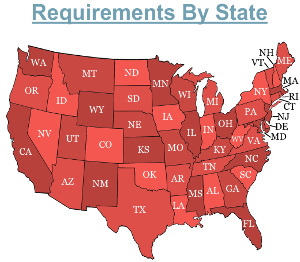An optician is an important member of the eye care team who can have a dramatic impact on the success of an optical establishment. The optician frequently allocates a greater amount of time for interacting with customers than anyone else on the team. While an optician does not receive the kind of extensive professional training as that of an optometrist or physician, they often receive a salary that is in-line with their level of expertise and their impact on the business.
The Bureau of Labor Statistics estimated the median annual wage of opticians to be $32,940 in May 2010. Indeed.com currently estimates the national average salary for opticians at around $33,000. The numbers referenced above reflect median wage. The bottom 10 percent of opticians earned less than $21,070 in 2010 while the top 10 percent earned more than $50,780 in 2010. As you can see, an optician salary can vary depending on a few different factors. You can also find your state specific median salaries in a table at the bottom of this page.
Business Size and Services
The first factor to consider when determining what an optician can expect to be paid is the type of establishment where the optician is employed. General merchandise stores and health care stores typically pay the most because the majority of their business is built on retail sales. An optician who is able to spend more time selling eyeglasses and less time making frame adjustments can generally expect to bring in more revenue for their employer and consequently receive a higher salary. Many of these types of employers offer generous bonus structures and incentive programs for particular products and services. Opticians who are good at focusing on selling products with high payout structures can expect to enjoy a higher optician salary.
Ophthalmology and optometry offices pay slightly less than general merchandise stores because retail sales represent a smaller portion of their revenue. Settings like these place a greater emphasis on medical eye care services and specialized frame and lens offerings. For this reason, fewer customers will be visiting the business for the sole purpose of purchasing eyeglasses. This does not mean that all optometry and ophthalmology offices offer a lower optician salary. Some of these offices are very business savvy and offer similar payout structures to general merchandise stores. Employers who have a medical component may appeal to opticians who want to use more of their specialized fitting and lens customization skills as opposed to being just a salesperson.
Education, Training, and Certification
Another important factor to consider when estimating the optician salary that one can expect to receive is the education, training, and experience of the applicant. Employers often pay a higher salary to individuals who have a college degree or an apprenticeship and who have successfully passed the American Board of Opticianry (ABO) Exam and the National Contact Lens Examiners (NCLE) Exam. Credentials help to demonstrate competence and establish credibility with employers.
Opticians who have these credentials typically possess a more comprehensive understanding of current standards and practices. Optical employers also know that they can use optician credentials to market their business to customers who hold credentialed opticians in higher regard. Those seeking a higher optician salary are encouraged to voluntarily pursue the credentials outlined above.
Geographic Location
A third factor to think about that will affect the amount that an optician is paid is the geographic region where the optician works. The number of available positions varies greatly between states and the size of the optician salary is generally affected by the cost of living in specific regions of the country. The Bureau of Labor Statistics found that the top five states for available optician jobs include California, Texas, Florida, Illinois, and Ohio. Opticians who want to improve their chances of getting a job should consider exploring opportunities in these states. While these states do employ more opticians than other states, they do not rank in the top five states that pay opticians the most. When it comes to the size of the optician salary, New York, Mississippi, Massachusetts, the Georgia, and California are the highest ranked. Each of these states pays opticians between $32,000 and $45,000 annually.
If you are considering specific metropolitan areas for employment, you should know which ones offer the most jobs and the highest pay. The top five metro areas with the most optician jobs include Chicago-Joliet-Naperville in Illinois, Los Angeles-Long Beach-Glendale in California, Dallas-Plano-Irving in Texas, New York-White Plains-Wayne in the New Jersey area, and Washington-Arlington-Alexandria in West Virginia/Maryland/Virginia/DC Metro. The top five highest paying metropolitan areas include Boston-Cambridge-Quincy in Massachusetts, Edison-New Brunswick in New Jersey, New Haven in Connecticut, Seattle-Bellevue-Everett in Washington State, and Hartford-West Hartford-East Hartford in Connecticut.
Summary
There are many different factors that can influence the size of the optician salary. New opticians often make less and gradually work their way up the pay ladder as they gain experience. Opticians who want to accelerate this process may want to consider formal education, training, and certification. Opticians who want to receive a more competitive optician salary may want to pursue the initial employment in offices that focus on retail sales and operate in geographic regions that offer higher pay.
Salary by State
| Alabama | $30,000 | $39,000 |
| Alaska | $25,000 | $33,000 |
| Arizona | $26,000 | $34,000 |
| Arkansas | $29,000 | $38,000 |
| California | $32,000 | $42,000 |
| Colorado | $25,000 | $34,000 |
| Connecticut | $31,000 | $42,000 |
| Delaware | $27,000 | $36,000 |
| Florida | $28,000 | $37,000 |
| Georgia | $32,000 | $42,000 |
| Hawaii | $21,000 | $27,000 |
| Idaho | $24,000 | $32,000 |
| Illinois | $31,000 | $41,000 |
| Indiana | $29,000 | $39,000 |
| Iowa | $27,000 | $36,000 |
| Kansas | $26,000 | $35,000 |
| Kentucky | $25,000 | $34,000 |
| Louisiana | $24,000 | $32,000 |
| Maine | $26,000 | $35,000 |
| Maryland | $29,000 | $39,000 |
| Massachusetts | $33,000 | $44,000 |
| Michigan | $28,000 | $38,000 |
| Minnesota | $26,000 | $35,000 |
| Mississippi | $34,000 | $45,000 |
| Missouri | $29,000 | $38,000 |
| Montana | $30,000 | $39,000 |
| Nebraska | $24,000 | $31,000 |
| Nevada | $27,000 | $36,000 |
| New Hampshire | $29,000 | $38,000 |
| New Jersey | $31,000 | $41,000 |
| New Mexico | $26,000 | $35,000 |
| New York | $34,000 | $45,000 |
| North Carolina | $29,000 | $38,000 |
| North Dakota | $27,000 | $36,000 |
| Ohio | $28,000 | $36,000 |
| Oklahoma | $27,000 | $35,000 |
| Oregon | $27,000 | $36,000 |
| Pennsylvania | $25,000 | $34,000 |
| Rhode Island | $29,000 | $39,000 |
| South Carolina | $26,000 | $35,000 |
| South Dakota | $23,000 | $30,000 |
| Tennessee | $27,000 | $36,000 |
| Texas | $27,000 | $36,000 |
| Utah | $26,000 | $34,000 |
| Vermont | $27,000 | $36,000 |
| Virginia | $29,000 | $38,000 |
| Washington | $28,000 | $37,000 |
| West Virginia | $29,000 | $38,000 |
| Wisconsin | $26,000 | $34,000 |
| Wyoming | $27,000 | $36,000 |
Optician Salary in Canada
The Canadian government classifies an optician under the group 31: professional occupations in health (3231). According to their statistics, the average annual income for someone working in the profession falls around $39,000 with approximately 16% of opticians earning over $50,000 per year. It is worth noting that, unlike the United States, most of the provincial regulatory bodies in Canada do require an optician to complete a formal college degree and a competency exam prior to becoming licensed. Currently, only about half of all states in the US have official regulations that establish detailed requirements for optician education, training, and licensure.
Working as an optician in Canada is similar to the United States in the sense that income is often variable depending on credentials, experience, and geographic location. Individuals who have a significant amount of experience in the industry are generally given preference in the hiring process because of the fact that they have demonstrated their knowledge and skills through previous employment. In addition, an experienced optician tends to require less of an orientation to the industry and often makes fewer mistakes. While it can be frustrating to try and land that first job, those who are new to the field can take comfort knowing that the size of the optician salary usually increases gradually as the years pass and one becomes more seasoned in the profession.
Readers can learn more about job openings in Canada by visiting the employment opportunities page located on the Opticians Association of Canada website. While the optician salary for these positions are not usually listed, those who are interested can contact the listing employer to learn more about the specifics of the opportunity and to learn about the organization in general.















I live in Georgia but am moving to the south Alabama area and was wondering if there are any schools that offer optician training programs? Thanks. I am hearing that the local technical college here in Valdosta, GA is fazing out their Opticianry program I am two semesters into their program and it looks like they are leaving current students in the wind. I found an Opthamalogic Assistant program (non-certificate) at Wallace Community College in Dothan, AL but I’m assuming this won’t work for Opticianry.
I am two semesters into their program and it looks like they are leaving current students in the wind. I found an Opthamalogic Assistant program (non-certificate) at Wallace Community College in Dothan, AL but I’m assuming this won’t work for Opticianry.
I live in San Francisco, California and was wondering if there are any schools that offer optician training programs? Thanks.
Kam,
Information relating to optician education, training, and certification in California can be found on the state specific page. American Career College is the only establishment that we are aware of that has received formal recognition in California.